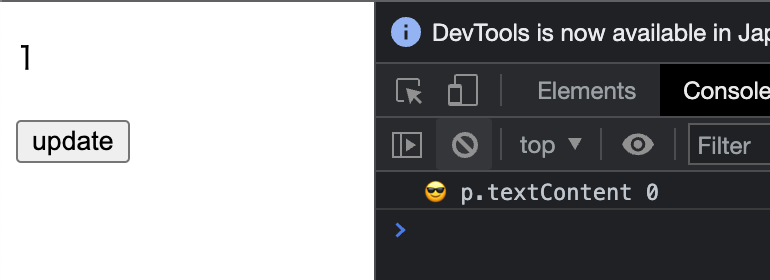調度器
調度 Effect
首先,看看這段程式碼:
import { createApp, h, reactive } from 'chibivue'
const app = createApp({
setup() {
const state = reactive({
message: 'Hello World',
})
const updateState = () => {
state.message = 'Hello ChibiVue!'
state.message = 'Hello ChibiVue!!'
}
return () => {
console.log('😎 rendered!')
return h('div', { id: 'app' }, [
h('p', {}, [`message: ${state.message}`]),
h('button', { onClick: updateState }, ['update']),
])
}
},
})
app.mount('#app')當按鈕被點擊時,state.message 上的 set 函式被呼叫兩次,所以自然地,trigger 函式也會被執行兩次.這意味著虛擬 DOM 將被計算兩次,補丁也會被執行兩次.

然而,實際上,補丁只需要執行一次,在第二次觸發時.
因此,我們將實現一個調度器.調度器負責管理任務的執行順序和控制.Vue 調度器的作用之一是在佇列中管理響應式 effect,並在可能的情況下合併它們.
使用佇列管理進行調度
具體來說,我們將有一個佇列來管理作業.每個作業都有一個 ID,當新作業入佇列時,如果佇列中已經有相同 ID 的作業,它將被覆蓋.
export interface SchedulerJob extends Function {
id?: number
}
const queue: SchedulerJob[] = []
export function queueJob(job: SchedulerJob) {
if (
!queue.length ||
!queue.includes(job, isFlushing ? flushIndex + 1 : flushIndex)
) {
if (job.id == null) {
queue.push(job)
} else {
queue.splice(findInsertionIndex(job.id), 0, job)
}
queueFlush()
}
}至於作業 ID,在這種情況下,我們希望按組件分組,所以我們將為每個組件分配一個唯一識別符(UID)並將其用作作業 ID.
UID 只是透過遞增計數器獲得的識別符.
ReactiveEffect 和調度器
目前,ReactiveEffect 具有以下介面(部分省略):
class ReactiveEffect {
public fn: () => T,
run() {}
}隨著調度器的實現,讓我們做一個小改變.
目前,我們將函式註冊到 fn 作為 effect,但這次,讓我們將其分為"主動執行的 effect"和"被動執行的 effect".
響應式 effect 可以由設置 effect 的一方主動執行,也可以在被添加到依賴項(dep)後被某些外部操作觸發而被動執行.
對於後一種類型的 effect,它被添加到多個 depsMap 並由多個源觸發,需要調度(另一方面,如果它被明確主動呼叫,則不需要這樣的調度).
讓我們考慮一個具體的例子.在渲染器的 setupRenderEffect 函式中,你可能有以下實現:
const effect = (instance.effect = new ReactiveEffect(() => componentUpdateFn))
const update = (instance.update = () => effect.run())
update()這裡創建的 effect,它是一個 reactiveEffect,稍後在執行 setup 函式時將被響應式物件追蹤.這顯然需要調度的實現(因為它將從各個地方被觸發).
然而,關於這裡呼叫的 update() 函式,它應該簡單地執行 effect,所以不需要調度.
你可能會想,"那我們不能直接呼叫 componentUpdateFn 嗎?"但請記住 run 函式的實現.簡單地呼叫 componentUpdateFn 不會設置 activeEffect.
所以,讓我們分離"主動執行的 effect"和"被動執行的 effect(需要調度的 effect)".
作為本章的最終介面,它將如下所示:
// ReactiveEffect 的第一個參數是主動執行的 effect,第二個參數是被動執行的 effect
const effect = (instance.effect = new ReactiveEffect(componentUpdateFn, () =>
queueJob(update),
))
const update: SchedulerJob = (instance.update = () => effect.run())
update.id = instance.uid
update()在實現方面,除了 fn 之外,ReactiveEffect 將有一個 scheduler 函式,在 triggerEffect 函式中,如果存在調度器,將首先執行調度器.
export type EffectScheduler = (...args: any[]) => any;
export class ReactiveEffect<T = any> {
constructor(
public fn: () => T,
public scheduler: EffectScheduler | null = null
);
}function triggerEffect(effect: ReactiveEffect) {
if (effect.scheduler) {
effect.scheduler()
} else {
effect.run() // 如果沒有調度器,正常執行 effect
}
}現在,讓我們在閱讀原始碼的同時實現佇列管理調度和 effect 分類!
到此為止的原始碼:
chibivue (GitHub)
我們需要 nextTick
如果你在實現調度器時閱讀了原始碼,你可能已經注意到"nextTick"的出現並想知道它是否在這裡使用.首先,讓我們談談這次我們想要實現的任務.請看這段程式碼:
import { createApp, h, reactive } from 'chibivue'
const app = createApp({
setup() {
const state = reactive({
count: 0,
})
const updateState = () => {
state.count++
const p = document.getElementById('count-p')
if (p) {
console.log('😎 p.textContent', p.textContent)
}
}
return () => {
return h('div', { id: 'app' }, [
h('p', { id: 'count-p' }, [`${state.count}`]),
h('button', { onClick: updateState }, ['update']),
])
}
},
})
app.mount('#app')嘗試點擊這個按鈕並查看控制台.

即使我們在更新 state.count 後輸出到控制台,資訊也是過時的.這是因為當狀態更新時,DOM 不會立即更新,在控制台輸出時,DOM 仍處於舊狀態.
這就是"nextTick"發揮作用的地方.
https://vuejs.org/api/general.html#nexttick
"nextTick"是調度器的一個 API,它允許你等待直到調度器應用 DOM 更改."nextTick"的實現非常簡單.它只是保持調度器中正在刷新的作業(promise)並將其連接到"then".
export function nextTick<T = void>(
this: T,
fn?: (this: T) => void,
): Promise<void> {
const p = currentFlushPromise || resolvedPromise
return fn ? p.then(this ? fn.bind(this) : fn) : p
}當作業完成時(promise 被解析),傳遞給"nextTick"的回呼被執行.(如果佇列中沒有作業,它連接到"resolvedPromise"的"then")自然地,"nextTick"本身也返回一個 Promise,所以作為開發者介面,你可以傳遞回呼或 await "nextTick".
import { createApp, h, reactive, nextTick } from 'chibivue'
const app = createApp({
setup() {
const state = reactive({
count: 0,
})
const updateState = async () => {
state.count++
await nextTick() // 等待
const p = document.getElementById('count-p')
if (p) {
console.log('😎 p.textContent', p.textContent)
}
}
return () => {
return h('div', { id: 'app' }, [
h('p', { id: 'count-p' }, [`${state.count}`]),
h('button', { onClick: updateState }, ['update']),
])
}
},
})
app.mount('#app')現在,讓我們實際重寫當前調度器的實現以保持"currentFlushPromise"並實現"nextTick"!
到此為止的原始碼:
chibivue (GitHub)
